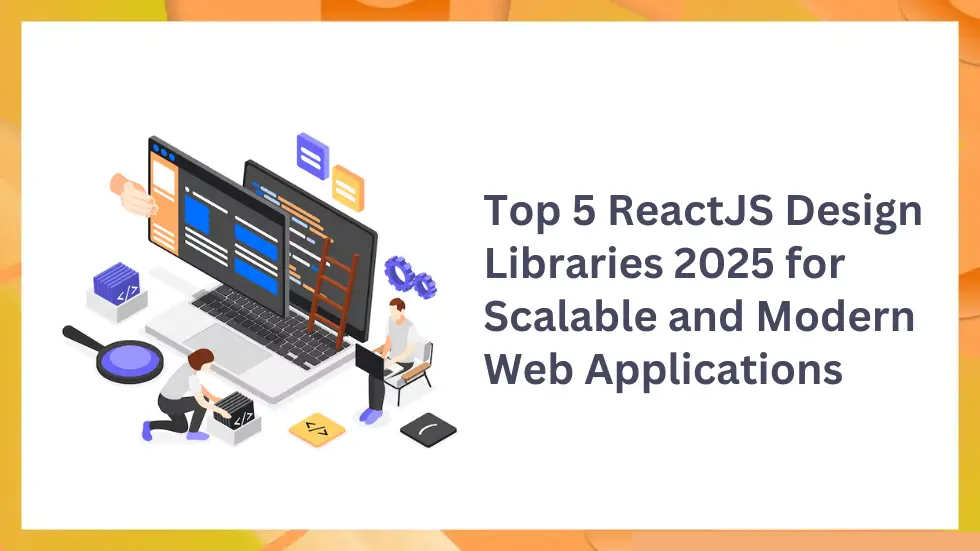Choosing the right UI toolkit is a crucial decision when building modern web applications with ReactJS. In 2025, the ReactJS design libraries ecosystem continues to evolve, offering developers powerful tools to speed up frontend development, maintain consistency, and deliver exceptional user experiences.
Whether you’re building enterprise dashboards, SaaS applications, or MVPs, using a pre-built React component library can dramatically reduce development time and cost.
This guide covers the top 5 ReactJS design libraries in 2025, each reviewed for its strengths, limitations, and ideal use cases—helping you make the right decision for your next React project.
🥇 1. MUI (Material-UI) — Best Overall for Enterprise-Grade Applications
MUI, formerly known as Material-UI, continues to lead the market as the most robust and widely adopted React UI framework in 2025. Backed by Google’s Material Design principles, it offers everything from responsive layouts to accessible components.
🔍 Highlights
- 100+ production-ready components
- Integrated theming and layout systems
- Built-in animation support
- Compatible with Emotion and styled-components
- Strong TypeScript integration
- Rich DataGrid and complex form components
✅ Pros
- Highly customizable with design tokens
- Excellent documentation and community support
- Ideal for scalable, enterprise UI development
❌ Cons
- Can be heavyweight for smaller applications
- Advanced customization may require deep styling overrides
🧠 Best Use Case
Use MUI for building admin dashboards, B2B SaaS platforms, or any large-scale application where consistency, accessibility, and developer efficiency are priorities.
🥈 2. Chakra UI — Most Developer-Friendly & Accessible
Known for prioritizing accessibility and developer experience, Chakra UI has quickly become a favorite for startups and frontend teams in 2025.
🔍 Highlights
- Accessible components out-of-the-box
- Seamless dark mode support
- Responsive design utilities built-in
- Fully composable architecture
- Optimized for TypeScript
✅ Pros
- Intuitive API and easy to learn
- Encourages semantic HTML and accessibility best practices
- Great for rapid development and MVPs
❌ Cons
- Smaller component set compared to MUI or AntD
- Not ideal for large-scale enterprise systems
🧠 Best Use Case
Perfect for SaaS dashboards, internal tools, portfolios, and rapid MVP development where time-to-market is crucial.
🥉 3. Ant Design (AntD) — Best for Complex Enterprise Applications
Created by Alibaba, Ant Design remains a powerhouse among ReactJS design libraries for enterprise apps, especially in sectors like finance and logistics.
🔍 Highlights
- Rich library of polished components
- Powerful table and form handling features
- Built-in i18n support
- Follows its own design guidelines for visual consistency
✅ Pros
- Feature-rich, perfect for data-heavy applications
- Strong documentation and enterprise support
- Offers its own design system for UI/UX consistency
❌ Cons
- Custom styling is less flexible
- Heavy bundle size
- Not mobile-first by default
🧠 Best Use Case
Recommended for complex dashboards, ERP platforms, fintech applications, and any product requiring advanced data visualization.
🏅 4. Tailwind CSS + UI Libraries (DaisyUI / Headless UI) — Best for Custom Design Systems
While not a UI component library per se, Tailwind CSS combined with DaisyUI or Headless UI allows for complete visual control and scalable styling.
🔍 Highlights
- Utility-first CSS framework
- Extremely lightweight with purge/tree-shaking
- Fully customizable design system
- Integrates well with React, Next.js, and Vue
- Headless UI offers unstyled, accessible primitives
- DaisyUI adds themeable, prebuilt UI components
✅ Pros
- Maximum control over design
- Efficient performance and minimal bloat
- Works great with dark mode and dynamic theming
❌ Cons
- Requires deeper understanding of CSS
- No visual design guidance unless enforced by your team
🧠 Best Use Case
Ideal for custom-branded apps, design-centric projects, portfolios, and scalable frontends where full UI ownership is a must.
🏅 5. ShadCN UI — Most Promising Hybrid UI Toolkit
ShadCN UI is a relatively new player in the React ecosystem, but its unique combination of Tailwind CSS and Radix UI primitives makes it stand out for 2025.
🔍 Highlights
- Built on top of Radix UI (for accessibility)
- Tailwind CSS styling out-of-the-box
- Clean, minimal component defaults
- Flexible and themeable architecture
- Designed with Next.js and TypeScript in mind
✅ Pros
- Excellent for modern SaaS platforms
- Clean, customizable components
- Developer-first tooling and flexibility
❌ Cons
- Requires manual setup
- Smaller ecosystem and community compared to MUI or AntD
🧠 Best Use Case
Best suited for modern, design-heavy apps like SaaS platforms, custom portals, or design systems that prioritize performance and scalability.
📊 Quick Comparison Table
| Rank | Library | Best For | Styling | Accessibility | TypeScript | Community |
| 🥇 1 | MUI | Enterprise apps, dashboards | ⭐⭐⭐⭐ | ✅ | ✅ | ⭐⭐⭐⭐⭐ |
| 🥈 2 | Chakra UI | MVPs, startups, dev experience | ⭐⭐⭐⭐ | ✅✅ | ✅ | ⭐⭐⭐⭐ |
| 🥉 3 | Ant Design | Complex data-heavy UIs | ⭐⭐⭐ | ✅ | ✅ | ⭐⭐⭐⭐ |
| 🏅 4 | Tailwind + UI | Custom branded applications | ⭐⭐⭐⭐⭐ | Depends | ✅ | ⭐⭐⭐⭐ |
| 🏅 5 | ShadCN UI | Modern design systems | ⭐⭐⭐⭐ | ✅ | ✅✅ | ⭐⭐⭐ |
🧩 Final Thoughts: Choosing the Right ReactJS Design Library in 2025
In 2025, selecting the right ReactJS design library depends on your project size, business goals, and development workflow.
- ✅ Use MUI or AntD if you’re building enterprise-grade, data-intensive applications.
- ⚡ Choose Chakra UI for rapid MVPs, SaaS apps, and accessibility-focused experiences.
- 🎨 Tailwind CSS (with DaisyUI or ShadCN UI) is perfect for custom, high-performance UIs with a modern design approach.
Regardless of your choice, all these best React UI libraries in 2025 provide solid foundations for building fast, maintainable, and beautiful applications.
Additional Resources:
